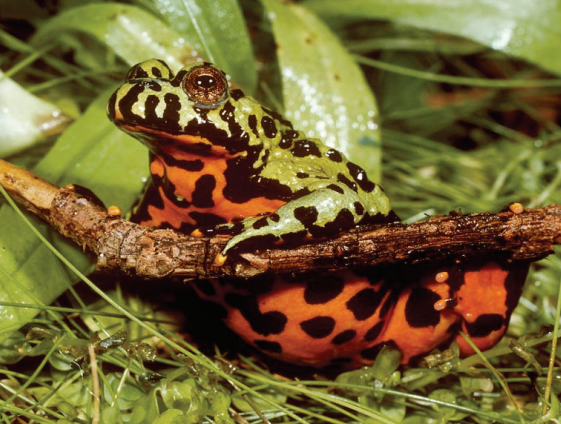Fire-Bellied Toad Facts
Fire-Bellied Toad Facts
1. This popular amphibian is a hardy species with fantastic natural colouration. Found in Asia, these amphibians are the grey area between the toad and frog classifications. The greens, reds and black on these animals vary between specimens, but generally they have a green and black back, and a red-orange and black stomach.2. Other species of fire-bellied toads live in Europe, North Africa, Russia, China, and northern Vietnam.
3. Amphibian means "two lives", not the common misconception of a life in water, and a life out of water, but rather, the life of a tadpole, and the life of the adult.
4. When frightened these amphibians will dive to the bottom of their water pool, or display their red stomach to you. The brightly colored belly acts as warning coloration to other species. The fire belly toad secretes a toxin when stressed. Fire-bellied toads secrete toxins from their skin as a defense mechanism. These toxins are usually no threat to humans; however, a few sensitive individuals develop skin rashes after contact with a fire bellied toad.
5. Captive-bred and captive-raised Oriental fire-bellied toads can live up to sixteen years, and there are claims of individuals living more than twenty years.
6. During the evenings and night time you can often hear males calling, sounding like a dog barking in the distance.
7. This toad’s coloration ranges from grass green to forest green with black blotches. The underbelly ranges from a flame red to a weak orange in color.
8. Body is covered with rough warts or tubercles. It has a small round head and large eyes with triangular pupils
9. They reach a maximum length of about 2 inches with females larger than males. Males have more warts than the females do.
10. The Oriental fire-bellied toad is typically active during the day.
11. They primarily perceive prey through movement. They wait patiently for their prey to draw near and then pounce quickly to capture the prey.
12. Fire Bellied Toads are carnivores. They will eat a variety of small insects including crickets, small waxworms, blood worms, small earth worms, baby roaches, and fruit flies.
13. During breeding season, males develop nuptial pads on their forearms, and will call out for a mate with a soft “wooh wooh”, which sounds like a dog barking in the distance.
14. This family of toads cannot extend their tongues like other toads or frogs. To feed they must leap forward and catch their prey with their mouths.
15. In case of extreme danger, Bombina orientalis can flip over on their back and expose their orange/red belly.
16. They can also excrete a poison that can cover their entire body with a soapy foam .
17. Male toads do not have a resonator, they actually make calls through inhalation rather than exhalation .
18. This toad hibernates from fall to late spring, on land in rotten trees, heaps of stones and leaves.
19. When threatened, fire-bellied toads perform an unusual behavior that biologists describe as the Unken reflex. The frogs arch their backs downward and raise the palms and soles of their feet to expose their brightly colored bellies. In some cases, the frogs go one step further and flip upside down to expose their colorful bellies. If turned right side up, the tendency to perform this behavior is sometimes so strong that they flip upside-down again. Amphibians performing the Unken reflex typically to produce toxic skin secretions and have bright ventral warning colors.
20. Fire-bellied toads are not true toads. These frogs were recently separated from the disc-tongue frogs (Discoglossidae) and placed in their own family, Bombinatoridae, which includes six species of fire-bellied toads (Bombina ) and two species of water toads (Barbourula ).
21. The most bizarre and impressive of the fire-bellied toads is the textured, heavily warted giant fire-bellied toad (Bom.maxima) from southwestern China and northern Vietnam. With a dark gray green back and mostly solid red belly, it reaches a length up to 3.5 inches.
22. The adult males of Orange-bellied Frog dig burrows in the soil and females lay their eggs inside the burrows.


Hello, my name is Marlene. I have 2 Fire Belly toads approximately 6yrs old. One of them looks very blotted, he looks like he's going to explode. I'm hoping you can help.
ReplyDelete